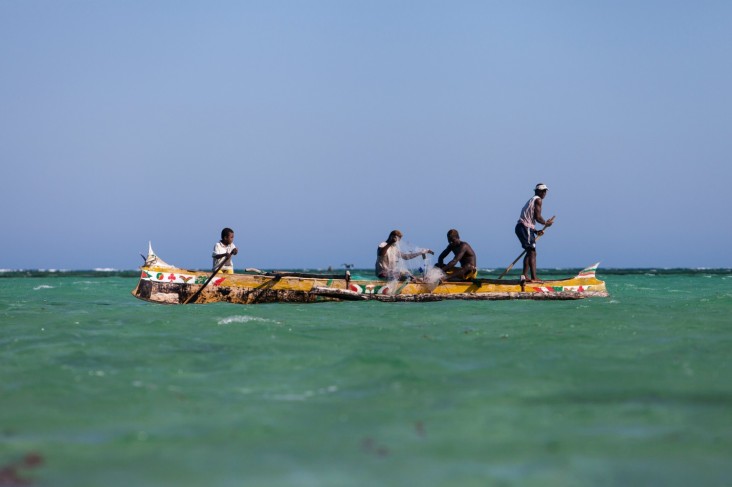
Local management of marine areas is an increasingly popular way to promote responsible and sustainable fishing
Our destination was remote. It took four hours of driving, through 20kms of rough terrain and bumpy roads, for our USAID team to reach Rantohely, a small fishermen’s village along the Bay of Antongil in northeastern Madagascar. Perhaps because of the physical isolation, these were a people used to managing things on their own. That may be a reason why the LMMA – Locally Managed Marine Area – approach to managing marine resources had so quickly caught on here. We were there to do an assessment of how the LMMA approach was working.
We were greeted at the entrance of the village by a collection of clamoring, noisy kids and the president of the local fishermen’s association, Augustin Randriamiharisoa. He was flanked by the community chief and a group of fishermen who had just returned to the village after going out to sea at daybreak.
Two of the fishermen’s associations had been managing LMMAs in Rantohely since 2012, which local people would refer to as “Tahirin-daoko”, or fish reserves in Malagasy. LMMAs are areas of ocean that coastal communities self-manage to help protect fisheries, safeguard marine biodiversity, amplify their community voices, and ensure the seas upon which their livelihoods depend remain productive. The idea behind LMMAs is simple, really: to entrust stewardship of marine resources to the people who are closest to those resources and who depend on them for their livelihoods. Those people are empowered to be sustainable managers of specific marine areas.
The fishermen reported the LMMA approach was valuable, had delivered benefits to the communities and that they were very motivated to create more LMMAs.
“We are very eager to develop our locally managed marine area in our community because, as fishermen, we know the LMMA will help us improve our livelihood. We look forward to closely working with any organization that may help us further develop our LMMA and improve our living conditions,” said Mr. Augustin.
Turbulent Waters
The LMMAs are facing some challenges. The large commercial fishers that operate boats in the area do not always comply with the established rules not to fish within 3.8km from the shores - a fishing zone where fish and prawns are often found because they lay eggs and reproduce around the mouths of rivers, coral reefs, rocks and mangroves. This is a territory that is supposed to be reserved for traditional fishers.
President Augustin explained that it has also been difficult to enforce the rules established by the LMMAs because of corrupt practices and lack of awareness of the laws by the very law enforcement officers. Moreover, an increasing demand for fish and prawns, damage from cyclones and river sedimentation, and the violation of rules by some community members are depleting fish and prawn stocks. There is a need to establish clear-cut boundaries for the fishing zones so that seasonal restrictions on fishery access are respected, he explained.
Cooperation with law enforcement authorities should also be strengthened to ensure enforcement of the rules. An increasing local population and impacts of climate change are also challenges, but ensuring that these critical marine habitats and breeding grounds are actually protected would go a long way towards ensuring that the local fish population remains healthy and is not over-fished.
Spawning a New Approach
Madagascar’s first LMMA was established in 2005 in the southwest. In response to dwindling catches, 25 villages joined together to jointly manage their marine resources. The success of the project sparked interest in other locations. In 2012, a meeting of community members representing 18 LMMAs took place during which they recognized the need to identify common challenges and share experiences and skills. This led to the establishment of a national LMMA network called MIHARI (Mitantana HArena an-dRanomasina avy eny Ifotony or ‘marine resources management at the local level’). Today, more than 120 community associations are participating in over 65 LMMAs.
Vatosoa Rakotondrazafy, is the Coordinator of the MIHARI Network and a former LMMA researcher at British Columbia University. She says that while some LMMAs are started by NGOs, many are established at the initiative of the communities, and, “the ultimate goal is to have LMMAs that are not too dependent upon NGOs.” To make this possible, the capacity of LMMAs management teams will need to be strengthened, in order to make the teams more self-sufficient.
Rakotondrazafy asserts that time has proven the LMMA approach works. “Although the benefits are not for the moment measurable, established LMMAs are contributing to Madagascar’s coastal and marine resource conservation, improving the communities’ livelihoods, and involving them directly with resource management.”
USAID is keen to provide assistance to improve fishermen’s livelihoods and at the same time contribute to marine biodiversity conservation through fisheries development in Madagascar. For the first time in its history, USAID is planning to help in marine and coastal resource management and conservation as part of an upcoming new 5-year conservation and communities program.







Comment
Make a general inquiry or suggest an improvement.